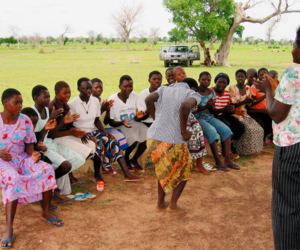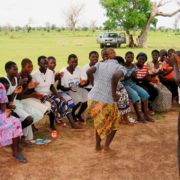Ending Female Genital Mutilation
February 6 is International Day of Zero Tolerance for female genital mutilation (FGM).

Adolescent girls in Ghana participate in a livelihood training aimed at reducing adoption of Female Genital Cutting (FGC).
© 2003 Melissa May, Courtesy of Photoshare
More than 200 million women and girls alive today have undergone female genital mutilation/cutting (FGM/C) according to the World Health Organization. While reports suggest that the rate at which FGM/C is practiced is dropping in some areas, as many as 30 million girls under the age of 15 may still be at risk for the procedure. The practice is most common in the western, eastern and northeastern regions of Africa, in some countries in Asia and the Middle East, and among migrants from these areas to North America and Europe.
According to WHO, “FGM has no health benefits, and it harms girls and women in many ways. It involves removing and damaging healthy and normal female genital tissue, and interferes with the natural functions of girls’ and women’s bodies. Generally speaking, risks increase with increasing severity of the procedure.”
For those who live with FGM, raising awareness of its health consequences, and linking these women and girls to available health services, continues to be a priority.
Why is FGM/C performed?
The reasons why FGM/C is performed vary from one region to another as well as over time, and include a mix of sociocultural factors that play out in families and communities. Some of the most commonly cited reasons are rooted in the fact that FGM/C has become a social norm and therefore there is pressure to conform.
Specifically:
- It is considered a necessary part of raising a girl
- It is often motivated by beliefs about what is considered acceptable sexual behavior – i.e., lessening female sexual pleasure
- It aims to ensure premarital virginity and marital fidelity
- It is thought to increase marriageability
- It is is associated with cultural ideals of femininity and modesty
Who performs it?
FGM/C is mostly carried out by traditional practitioners, who often play other central roles in communities, such as attending childbirths. However, health care providers now perform more than 18 percent of all FGM/C in countries where it is traditionally practiced, and the trend towards “medicalization” is increasing. Health care providers need support and training to abandon the practice, which can lead to a range of physical and mental health problems, regardless of who performs it.
How will it be eliminated?
To eliminate FGM/C, WHO and other leading international health organizations favor an approach which:
- Enlightens individuals and families about the physical and mental health problems caused by FGM/C
- Strengthens communities to eliminate FGM/C
- Strengthens the health sector response
- Builds evidence
- Increases advocacy
- Works to change national policies
Social and behavior change communication (SBCC) has been critical in:
- Changing social norms
- Mobilizing community action
- Advancing human rights and gender issues
- Informing the public
- Motivating health care workers
- Educating community and religious leaders about the serious dangers caused by this practice
- Raising awareness about the role of social norms and gender inequalities that underlie the practice
- Reaching a variety of groups including leaders, men, women and youth (girls and boys) to engage many audiences in the effort to change the social norm
In the latest Trending Topic, the Health COMpass focuses on tools and project materials created for SBCC efforts to end FGM/C.
Add your own materials to this collection – please do so by registering and contributing your own resources with the community.








Leave a Reply
Want to join the discussion?Feel free to contribute!